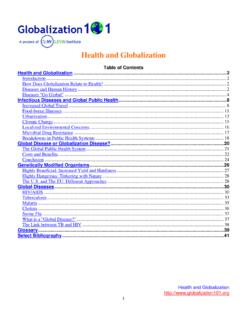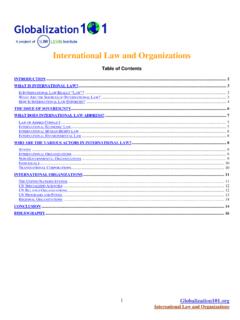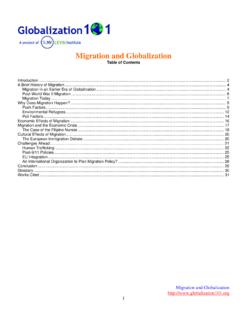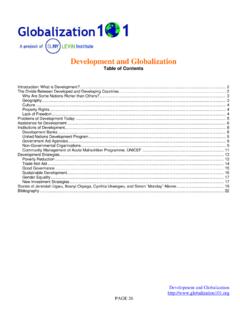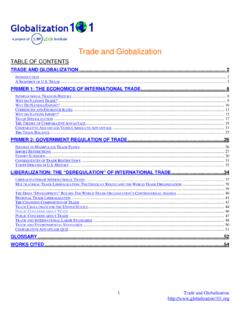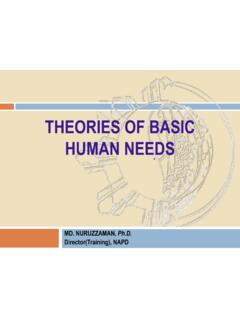Transcription of Human Rights - Globalization101
1 1 Human Rights Contents I. Introduction: What are Human Rights ? .. 3 Origins of Human Rights .. 3 Three Generations of Human Rights .. 6 Major Ideological Tensions within Human Rights Doctrine .. 8 Negative vs. Positive Rights .. 8 Rights vs. Duties .. 9 Universality and Western Imperialism .. 10 The Universal Declaration of Human Rights .. 13 The Document .. 14 Key International Documents .. 18 The International Bill of Rights .. 18 International Covenant on Civil and Political Rights .. 20 Extension of Human Rights Beyond the International Bill of Rights .. 22 Monitoring and Enforcement .. 23 UN Architecture .. 24 Human Rights and Violence .. 26 Torture and Inhuman Treatment .. 27 The Geneva Conventions .. 27 UN Efforts to Secure Freedom from 28 Non-Derogability and State Sanctions: Unlawful Combatants?
2 29 Non-Refoulement: Extraordinary Renditions and Outsourcing Torture .. 32 Genocide .. 35 Criminalizing Genocide in International Law .. 36 Courts and Justice in International Law: The Post-World War II Military Tribunals .. 39 The Persistence of Genocide and Subsequent UN Tribunals .. 40 International Criminal Court (ICC) .. 42 Interventions .. 46 The Problem of Humanitarian Intervention .. 46 Peacekeeping in Bosnia .. 47 Intervention in Kosovo .. 49 Humanitarian Intervention in Perspective .. 50 Responsibility to Protect (R2P) .. 51 Impact of Globalization .. 52 Indigenous Rights .. 52 2 Individual Rights or Group Rights .. 53 Land and Environment .. 54 Cultural Rights .. 56 Self-Determination .. 57 Women s Rights .. 58 Reproductive Rights and Sexual Autonomy .. 60 Human Trafficking.
3 62 Children s Rights .. 65 Child Labor .. 66 Child Soldiers .. 69 Juvenile Justice .. 71 Changing Players: Abusers and Guarantors of Human Rights .. 72 State Actors .. 73 Transnational Corporate Actors .. 73 Social Movements and NGOs .. 74 Works Cited .. 88 3I. Introduction: What are Human Rights ? The era of globalization is also the era of the individual. Revolutionary innovations in technology and telecommunications have empowered the individual, for better or worse, to exercise a previously unthinkable degree of self-expression. The same age that has seen the advent of the threat of global terror networks is also the one that has given birth to YouTube. This focus on the individual is part of a broader trend that has been underway for centuries and has only intensified since the end of the Second World War.
4 One of its most important manifestations in the twentieth and now twenty-first century has been the development of a conceptual and legal framework for Human Rights as well as a new dimension of civil society dedicated to ensuring that these Rights are protected. Human Rights recognize the dignity inherent in every person as a Human being, regardless of his or her particular nationality, race, ethnicity, religion, gender, sexuality, class or any other group affiliation or characteristic. As a result, they assert the moral and legal primacy of the individual over other entities that have Rights , such as the family and the state. Though Human Rights are purportedly universal and self-evident, scholars struggle to justify their existence, enumeration, and international enforcement.
5 What are the metaphysical and epistemological foundations for the existence of Human Rights ? Which Rights , if any, are truly fundamental and universal? If particular Human Rights -- or indeed even the concept of Human Rights in itself -- are not recognized universally, can the nations that do subscribe to Human Rights legitimately involve themselves in the Human Rights abuses of nations that don t? Is it plausible to suppose we can reach a truly universal agreement on what Human Rights are? This Issue will examine the history of Human Rights and survey some of the key debates about how these Rights should be applied in current real-world situations. Origins of Human Rights The emergence of Rights in political thought is generally regarded as relatively recent, though any historical study of Rights reveals how indeterminate the philosophical charting of the evolution of Rights has been (Renteln, 1988).
6 Human Rights are considered the offspring of natural Rights , which themselves evolved from the concept of natural law. Natural law, which has played a dominant role in Western political theory for centuries, is that standard of higher-order morality against which all other laws are adjudged. To contest the injustice of Human -made law, one was to appeal to the greater authority of God or natural law. 4 Eventually this concept of natural law evolved into natural Rights ; this change reflected a shift in emphasis from society to the individual. Whereas natural law provided a basis for curbing excessive state power over society, natural Rights gave individuals the ability to press claims against the government (Renteln, 1988).1 This modern conception of Rights can be traced back to Enlightenment political philosophy and the movement, primarily in England, France, and the United States, to establish limited forms of representative government that would respect the freedom of individual citizens.
7 John Locke, in his Second Treatise on Government (1690), described a state of nature prior to the creation of society in which individuals fended for themselves and looked after their own interests. In this state, each person possessed a set of natural Rights , including the Rights to life, liberty and property. According to Locke, when individuals came together in social groups, the main purpose of their union was to secure these Rights more effectively. Consequently, they ceded to the governments they established only the right to enforce these natural Rights and not the Rights themselves ( Human Rights : Historical Development, ). Locke s philosophy, known as classical liberalism, helped foster a new way of thinking about individuals, governments, and the Rights that link the two.
8 His principles were adopted by the founding fathers of the United States in the Declaration of Independence (1776), which states: We hold these truths to be self-evident, that all men are created equal, that they are endowed by their Creator with certain unalienable Rights , that among these are Life, Liberty and the pursuit of Happiness. That to secure these Rights , Governments are instituted among Men, deriving their just powers from the consent of the Similarly, the language used both by Locke and by the Founding Fathers clearly foreshadows the creation of a document like the Universal Declaration. These principles were further expounded and enshrined in the Constitution (1787) and Bill of Rights (1789). Natural Rights theorists have asserted the existence of specific Rights -- most notably the right to self-preservation (Hobbes) and the right to property (Locke).
9 Because such theorists take the validity of fundamental Rights to be self-evident, there has traditionally been little tolerance for debate. One scholar notes that natural Rights seemed peculiarly vulnerable to ethical skepticism (Waldron 1984: 3). Nevertheless, natural Rights were not widely contested as they were asserted in a limited universe of shared Western values (Renteln, 1988). What, then, is a right, and how are Human Rights distinct from natural Rights ? For many philosophical writers, a right is synonymous with a claim. The Oxford English Dictionary defines a right as a justifiable claim, on legal or moral grounds, to have or obtain something, or 1. For more on the relationship between natural law and natural Rights , see L.
10 Strauss (1953), M. Roshwald (1959), and J. Donnelly (1985). 5act in a certain way. The classic definition of a Human right is a right which is universal and held by all persons: A Human right by definition is a universal moral right, something which all men, everywhere, at all times ought to have, something of which no one may be deprived without a grave affront to justice, something which is owing to every Human being simply because he is Human . (Cranston 1973: 36) One frequently cited definition of Human Rights posits four necessary requirements: First, it must be possessed by all Human beings, as well as only by Human beings. Second, because it is the same right that all Human beings possess, it must be possessed equally by all Human beings. Third, because Human Rights are possessed by all Human beings, we can rule out as possible candidates any of those Rights which one might have in virtue of occupying any particular status or And fourth, if there are any Human Rights , they have the additional characteristic of being assertable, in a manner of speaking, against the whole world.

